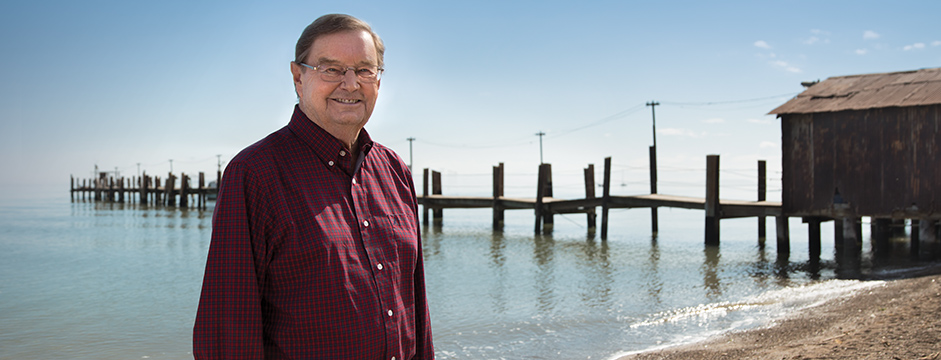John Ternullo - a Beat Ahead of Disaster
Heart

John Ternullo had already received a steady stream of visitors to the cardiac unit MarinHealth Medical Center (then Marin General Hospital), where he was recovering from a massive heart attack. But when a pretty blonde woman strolled into his room with a big smile on her face, he didn’t recognize her. “I’m Sandy,” she said. Sandy had been the cardiac nurse on the stellar cardiac catheterization team that saved John’s life. She was thrilled to see John talking and sitting up, and explained the reason for her visit. “I had to come see how you were doing because I have never worked on a patient as hard as I did on you. And you died on me four times.”
At 77, John was happily retired, enjoying his family, travel with his wife, and activities with his men’s group, the Son’s of Retirement. John is the captain of their bocce ball league and he had just finished a tournament at the bocce ball court in San Rafael when he began experiencing chest pain. John drove himself home – admittedly not a good decision – and called 911. When the paramedics arrived a few minutes later, John was awake, but his vital signs were not good. The paramedics had to stabilize him before taking him to the Emergency Department at MarinHealth Medical Center. Meanwhile, John’s wife called their daughter and the two drove to the hospital together.
John was conscious when he arrived at the hospital. He remembers being intubated, right before he had the first of 4 cardiac arrests. The next thing he recalls is seeing the “light at the end of the tunnel,” so often described by people who have had a near death experience. John’s wife and daughter could hear the Code Blue alarm from the waiting room and waited anxiously for news. Meanwhile, the care team was racing to save John, with repeat electric shock and chest compression. As soon as they got him stabilized, they put him in an induced coma and wheeled him to the cath lab.
As a cardiac emergency, John was lucky he was taken to a Certified Chest Pain Center. The Medical Center's cath lab team has extensive experience with the minimally invasive radial artery approach to cardiac catheterization, which many area hospitals are just beginning to master. Their average “door-to-treatment time,” – the time between a patient’s arrival at the hospital and emergency angioplasty – is 46 minutes faster than the national average. This is critical, because, as cardiologists say, “Time is muscle.” The more time that elapses between the onset of a heart attack and cardiac catheterization, the greater the chance of permanent damage to the heart muscle. MarinHealth Medical Center boasts outstanding outcomes, including a success rate for coronary intervention that consistently exceeds 98 percent. Still, it was touch and go for John. Two of his arteries were completely blocked. Going in through an artery in John’s groin, interventional cardiologist Dr. Robert Sperling threaded two stents up to his heart to push open the walls of his blocked arteries and get John’s blood flowing again.
Meanwhile, Dr. Adam Baumgarten, who has since become John’s regular cardiologist, had come out to talk to John’s wife and daughter. He hugged Mrs. Ternullo and told her to prepare for the worst. John had “died” four times. His brain had been deprived of precious oxygen, and even if he survived, he might never be the same. While anxiously waiting for news of her husband’s procedure, Mrs. Ternullo had struck up a conversation with a Catholic priest who happened to be in the waiting room, and he agreed to perform the last rights for John, just in case.
Three days later, John woke from his induced coma. There was no apparent brain damage: he knew who he was, and where he was, and he recognized his wife and daughter instantly. He had no recollection of what had happened to him, but he was very concerned about having to miss his bocce ball tournament the next morning! During the 12 days John spent recovering in the cardiac ward, every nurse who had participated in his catheterization stopped by to wish him well. One of them joked that he looked “so much better vertical, with his clothes on!” Whenever John got out of bed and took his walker for a spin, the staff cheered him on. As he describes it, “Walking down the hall, it was like I was at the marathon finishing line. The care was so individualized, I felt like I was the only patient there.” John’s doctors had originally planned on fitting him with a pacemaker or an electric vest but John’s recovery was so remarkable, it was determined that he wouldn’t need either one. After discharge, John spent two weeks in a rehabilitation facility. Then, he went home and did 3 months of outpatient rehabilitation at MarinHealth Cardiovascular Medicine | A UCSF Health Clinic.
Like many heart attack patients, John had started his recovery feeling a little depressed, but as he gazed out at the view of Mt. Tam from his room and took in what had happened to him, he realized that “These eleven angels had given me a second chance.” Determined to give back to the hospital that gave him back his life, John joined MarinHealth Medical Center’s volunteer group. Today, he has become a regular visitor to the cardiac specialty unit where he was once a patient, cheering patients on with the story of his miraculous recovery. He’s also resumed his duties as Captain of the Son’s of Retirement Bocce Ball League, his aim as true as ever.
This story was first published in October, 2015.

